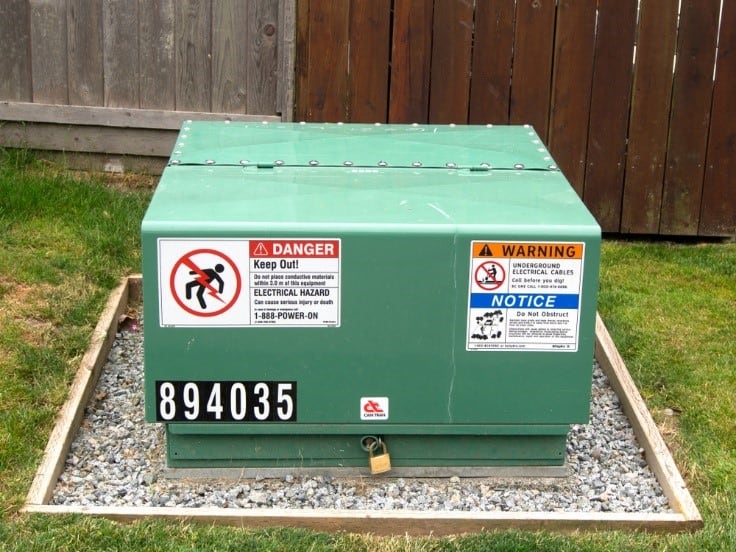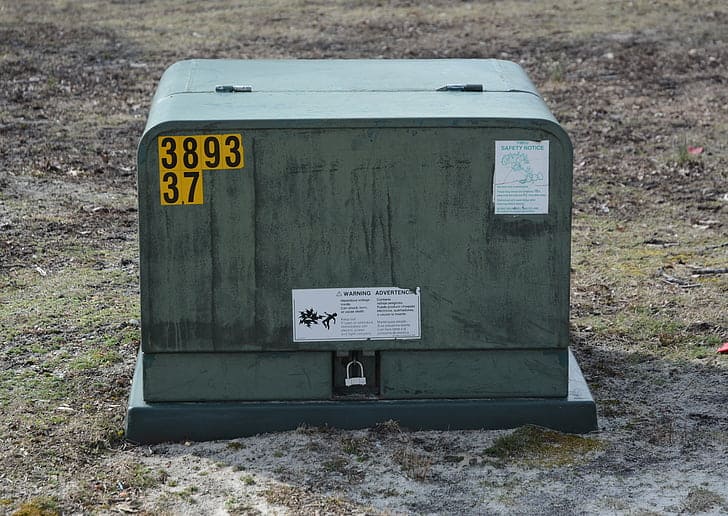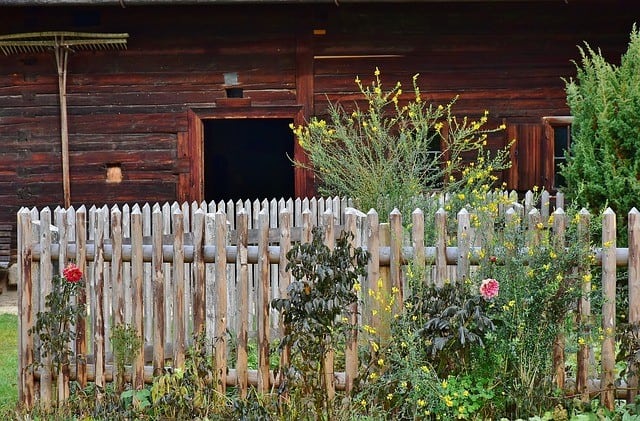Transformer boxes are an essential component of your utility system that you can’t do without. And you happen to be the kind neighbor who has to “house” this unsightly beast on your property.
They have to be placed somewhere, and the unfortunate resident or owners of these locations are faced with the challenge of living with these electric utility boxes in their yards.
The sensitive nature of a transformer or utility box also means you cannot move it. When you hide a utility box, you should leave an allowance for it to breathe, and it should be easily accessible at all times for emergencies and maintenance.
That being said, pad-mounted transformers are an eyesore in a well-kept yard for several reasons; they were built for function and not beauty, so they are usually bland with odd colors, their sizes can be imposing in your yard, and they will most likely contrast with the rest of your landscaping.
The only plausible option you are left with if you want to maintain your aesthetic ambiance is to hide the transformer box in your yard. We will share a few ideas on how to hide the padmount transformer in your yard and how to go about it with some creativity and maybe even some ease.
Understanding Your Limitations
Due to the sensitive nature of these transformer boxes, any beautification project around it has the potential to cause irreparable damage and is also risky, so it should be approached with caution.
The transformer boxes will often have notices or warning labels; this is the first place you should look. However, the information may not be sufficient, especially for the layman, so it is good practice to confirm with the utility company or whoever is responsible for the transformer box.
The information you will be looking for includes the amount of clearance required for their technicians to access the transformer box and whether there are underground utilities near the transformer that can present a safety risk if you dig it.
The company will let you know how much space is required to conveniently access the transformer box, provide the offset distance (how far away from it other items should be placed to allow aeration) and also mark the location of any underground cable or power line, so you can avoid them when doing your landscaping. This also helps you avoid infringing on any rules and regulations regarding the transformer box.
Different Ways to Hide a Transformer Box in Your Yard
Hiding the Transformer Box Using Barriers
This is the most straightforward way of ridding your yard of the eyesore while still allowing easy access for utility workers. It is applicable when you are not interested in anything beyond simply hiding the green electrical box. There are different approaches to consider if you choose this route:
Erecting an aesthetically appealing fence around the green metal box that is at least the same height
Putting up lattice panels around the transformer box is even more attractive than the fence because of the squares and diamond shapes left between wood or metal strips
Building a wooden box that is slightly bigger than the electrical box, which is then slipped on top of the box
Whichever method you opt for, always ensure the transformer has breathing space and is easily accessible for maintenance and monitoring by the utility company.
You can build a 3-sided enclosure, leaving one side open (the one that is least disruptive to your yard’s ambiance). There is also the option of having one of the panels hinged or building a door that can be opened and closed as per your needs.
Also, consider making one or more panels mobile, making them easy to move as the need arises. You can mount them on casters or wheels instead of setting them into the ground. To control their mobility, you can use lockable casters or wheels or chain the mobile panels to anchor points.
Concealing the Transformer Box with a Plant Screen
This trick does more than just hide the transformer box; it helps blend in with the rest of the landscaping. A couple of options can be used for the screen: hedges, ornamental grasses, and potted plants.
Hedges and Shrubs
For hedges, you can consider emerald arborvitae (also known as smaragd–yes, that is no typo. “smaragd” it is), whose sizes make them great natural privacy screens (they grow to between 10 and 15 feet high and 3 to 4 feet wide).
You also have the north privet, America’s fastest-growing deciduous hedge with attractive dark green foliage tolerant to shearing and designing. It grows up to 12 feet with a maximum width of 6 feet. Shrubs are another great option.
Ornamental Grass
Effective ornamental grass, like fountain grass, is a hardy, perennial, mound-forming grass with a fountain-like appearance and minimal maintenance. The densely clumped growth of ornamental grass makes it a good screening plant, and its flowers make it aesthetically appealing.
Its foliage display during fall and winter is also remarkable. Another option is feather reed grass, which grows in tufts and has a vibrant display of flower heads that transform into grain-like seeds.
Potted Plants
Potted plants offer certain unique advantages over the other plants, which might encourage you to use them instead. They are portable, which means you can easily move them whenever access to the electrical transformer box is required.
The potted plants will be left intact after such service visits or emergencies. You also don’t have to worry about interfering with underground cables as they don’t require digging, and their roots are well contained within their respective pots.
Their only shortcoming is that they are more susceptible to vandalism and theft because of the same portability that makes them convenient. You may have to come up with anti-theft systems for peace of mind, which will reduce their portability and might defeat the purpose.
You should refer to the plant hardiness zone map by the United States Government’s Department of Agriculture (USDA) to choose the plants most likely to thrive in your location. It is an innovative agricultural research service by the USDA that classifies zones based on variables like soil type and topography to eliminate the guesswork from farming and gardening.
All you need to do is enter your ZIP code in the search box of the GIS-based map to get your zone; then, you can decide which plants will help you optimize your land use without damaging the environment.
Before settling on the plant, find out everything you can about the root system. If the roots grow too deep, they might still interfere with the underground wiring. Another important consideration is the root ball (the roots’ radius can spread to when the plants are fully grown).
You should also be extra careful with vining plants; they might climb the transformer box as they grow, restricting access to it. Ensure your plant screen leaves sufficient space to access the box.
Using Freestanding Yard Privacy Screens
This is a pocket-friendly alternative to the permanent fences we talked about earlier. They are erected using wood, bamboo, or a host of other materials, depending on what is readily available and personal preferences.
You can build them with accurate measurements, which is better than waiting for plants to grow tall enough to sufficiently cover the transformer box. These screens will stand on their own, thanks to support posts made of wood or steel.
They will also protect your vegetation from wind damage and bear the weight of any climbing plants in the process. They are also a great backdrop to a garden bed when well executed. Just make sure the support posts are not intrusive to any underground wire or cabling and everything is still accessible by utility workers.
Diverting Attention Away from the Transformer Box
This is done by placing other decorative items so that they intentionally block the transformer box from view, masking it with a façade. You can put up a large garden statue or water fountain in front of the transformer box and create a large rock garden with boulders to cover the box or any other appropriate landscaping items.
Different Combinations of Solutions to Hide the Transformer Box
You don’t have to limit yourself to just one of the options above. We encourage you to try out different combinations to get that balance of cover, sustainability, and flexibility. A combination also enhances the natural feel of the yard.
Besides the transformer box and the concrete pad you are hiding, the rest of the yard is pretty much an open canvas, and the combinations can be as diverse as you want them to be.
Here are a few ideas to get you going:
• You can have the plants on one or more sides of the box and a mobile lattice panel on one side which will be the access point for maintenance and emergencies.
• You can transform the area around the transformer box into a specially designed garden featuring boulders and a fountain as part of the landscaping, providing both distraction and cover.
• Add planter boxes to the base of free-standing privacy screens, fences or lattice panels to support climbers, keeping with the yard’s theme.






